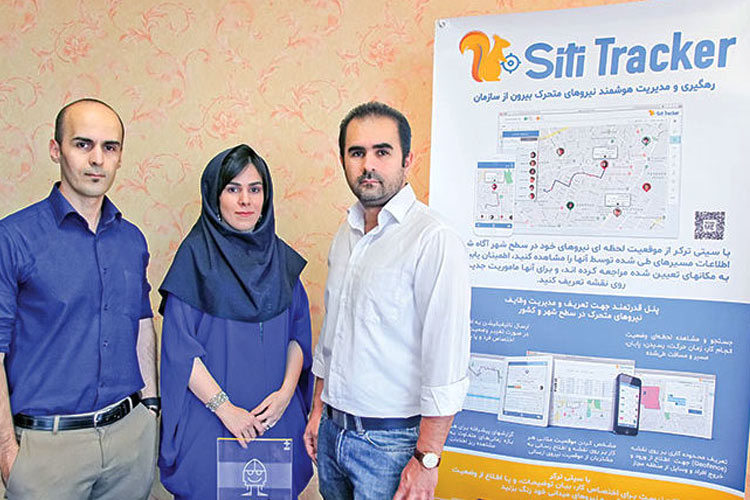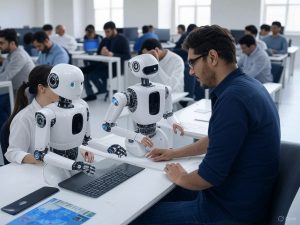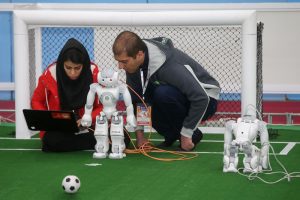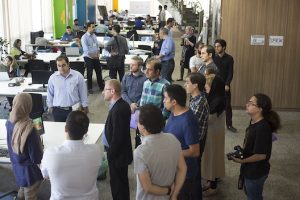Parinaz Sobhani: A Inspiring Journey
Parinaz Sobhani on AI’s Evolution and Impact, Featured on 16th Floor Podcast
From the 16th Floor podcast, hosted by Soheil Alavi, comes this insightful episode featuring Parinaz Sobhani, a prominent voice in the field of Artificial Intelligence. Parinaz’s journey, which began with early programming experiences in Iran , has led to significant contributions to AI innovation in Canada . In this interview, she shares with Soheil her academic background, including her studies at the University of Isfahan and Sharif University , and her extensive work in machine learning and natural language processing . The discussion also provides valuable context on the evolution of deep learning and Parinaz’s transition into venture capital . Through this conversation, listeners will gain a comprehensive understanding of Parinaz Sobhani’s impact on the AI landscape.
From Iran to Canada
Parinaz Sobhani‘s Journey in AI and Tech
Parinaz’s story begins in Iran, where her passion for programming took root in high school. Raised in an environment that encouraged her intellectual curiosity, she found her path early on through a gifted high school program that introduced her to programming—a subject not commonly offered in schools in Iran at the time. This early exposure to computer science shaped her academic and professional trajectory in ways she couldn’t have predicted at the time.
The Power of Programming: Discovering a New World
As Partinaz reminisces about her early days with programming, she recalls how she got involved with web design during high school, driven by the desire to create an aesthetically pleasing blog. She remembers using Persian blogging platforms like PersianBlog and Blogfa, which helped spark her interest in the world of programming, even before fully understanding its potential.
A Growing Interest in AI and Natural Language Processing
During her university years at the University of Isfahan, she explored topics like neural networks, which piqued her interest in AI. At Sharif University for her master’s program, she deepened her knowledge in artificial intelligence, particularly in machine learning and its mathematical foundations. It was during this time that she set her sights on solving one of AI’s most challenging problems—natural language understanding.
Bridging the Gap Between Linguistics and Machine Learning
Partinaz’s journey took another significant turn when she pursued a PhD in Canada, focusing on the difficult challenge of understanding human languages. With a background in machine learning and mathematics, she joined a community that was deeply divided on whether linguistic knowledge was necessary to process language computationally. Over time, her experiences would show her that the debate around linguistics versus computational approaches was not as crucial as it seemed—advancing AI through machine learning could lead to breakthroughs, even without traditional linguistic expertise.
Deep Learning and Brain Neural Networks: A Journey Through AI Evolution
How AI Mirrors Human Learning
Artificial Intelligence has evolved by drawing inspiration from human cognition, particularly the way our brain processes and stores information. This parallel between human neural networks and artificial neural networks has shaped the foundation of modern AI breakthroughs, including deep learning.
Parinaz Sobhani’s Academic Journey: From Isfahan to Sharif and Beyond
Parinaz Sobhani’s journey into AI began during her undergraduate studies at the University of Isfahan, where she took a neural network course that sparked her passion for machine learning. Recognizing the depth of the field, she pursued a master’s degree at Sharif University, where she built a strong mathematical foundation in artificial intelligence. She later moved to Canada to further her research, focusing on complex AI problems with long-term significance.
The Rise of Deep Learning: A Mathematical Revolution
Deep learning emerged as a transformative approach within AI, leveraging neural networks to process and interpret vast amounts of data. Parinaz highlights how early research in this field debated the necessity of linguistic knowledge versus purely computational approaches. She recounts how deep learning allowed AI to learn representations on its own, rather than relying on predefined mathematical models.
AI’s Breakthroughs: The Intersection of Technology and Data
The past two decades have seen a remarkable digital transformation, leading to an explosion of available data. With the advancement of GPUs and deep learning architectures like Transformers, AI has reached unprecedented capabilities. This synergy between hardware and AI models has propelled innovations such as ChatGPT, which can process and generate human-like language across multiple languages.
The Evolution of AI and Data: A Historic Shift
In this section, Parinaz Sobhani reflects on the evolution of AI over the years, from early attempts at Natural Language Processing (NLP) to the current state of machine learning and large language models (LLMs). Parinaz highlights a critical turning point in the AI journey: the digitization of human knowledge over the last 20 years, which has enabled the development of highly efficient AI models.
The advancement of AI wasn’t just a matter of having powerful GPUs or the right algorithms; it was about having the necessary data to feed these systems. According to Parinaz, AI requires three key ingredients: vast amounts of data, high processing power (via GPUs), and robust algorithms, notably the Transformer algorithm.
The Role of Transformers in AI’s Breakthroughs
Parinaz explains the significance of the Transformer algorithm, which has become a cornerstone of modern AI. However, she also brings up an interesting perspective: LLMs, although incredibly powerful, might not be the ultimate solution for all problems. Despite their success, there might be more efficient alternatives in the future.
She also discusses how OpenAI’s introduction of user-friendly chat interfaces brought the power of Transformers to the masses, making it easier for people to interact with AI and, in turn, boosting its capabilities.
Early NLP Work: Parinaz’s Contribution in 2012
Turning the clock back to 2012, Parinaz reflects on her pioneering work in NLP, which began when she was in China. She talks about a project that involved understanding context in text—specifically, the ability to distinguish between Apple the company and apple the fruit, based on surrounding words.
Back then, such advancements were groundbreaking. Parinaz’s team created innovative tools, including Chrome extensions that enhanced online experiences by providing instant contextual information. This early work laid the foundation for many modern AI-driven tools, such as the Wikipedia hover feature and Gmail’s contextual email insights.
The Origins of Sentiment Analysis: Parinaz’s Thesis Work
Moving on to her thesis, Parinaz highlights her research in sentiment analysis, particularly focusing on how opinions should be evaluated in context. She emphasizes that sentiment is not just positive or negative; it’s a nuanced, relative concept. For instance, the term “junk” could be either positive or negative, depending on the context. Parinaz discusses how understanding the target of a sentiment (e.g., a product or a political issue) is crucial to accurately interpreting opinions.
Her work explored the depth of sentiment analysis, diving into more complex cases like political discussions, where opinions can be highly polarized and context-dependent.
Rebranding AI: From Machine Learning to Data Science
Parinaz offers a unique perspective on the evolution of AI terminology. In her early years, the field was heavily focused on machine learning, with AI often seen as a broader, less defined concept. Over time, the rise of data science led to a shift in focus, and the term “data scientist” became the new buzzword.
She humorously recounts the transition from machine learning to data science, noting that the term “data scientist” was self-coined by the tech community, and it rapidly gained popularity, much like how AI has surged back into the spotlight today.
Next Steps: Bridging the Past and Future
In this segment, we have explored Parinaz Sobhani’s thoughts on the progression of AI, from early NLP challenges to current breakthroughs and industry rebranding. Each of these stages represents a critical shift, not just in technology, but in how we think about intelligence and machine learning. With each step, the field of AI has evolved, shaping the tools and frameworks we use today.
Other Branches of Artificial Intelligence You Should Know
When it comes to artificial intelligence, machine learning (ML) often dominates the conversation, but AI is much broader and includes a variety of other branches that contribute to solving complex problems. Let’s explore some of these lesser-known areas that are essential to AI’s full potential.
- Expert Systems
Expert systems are one of the early forms of AI, which gained traction around the 1980s. These systems use pre-programmed knowledge bases to solve specific problems in a certain domain, like medical diagnosis or financial analysis. Unlike modern AI systems that depend on vast amounts of data and machine learning, expert systems focus on encoding human expertise into decision-making rules. - Constraint Satisfaction and Planning
These are mathematical techniques used to solve problems where you must find the optimal solution under a set of restrictions or conditions. For example, constraint satisfaction involves solving scheduling problems or assigning tasks within constraints (like resource limitations). Planning goes hand-in-hand with this and involves creating a sequence of actions to achieve a specific goal, taking into account the constraints. These areas are foundational in AI, especially in robotics and operations research. - Symbolic AI
Symbolic AI, also known as classical AI, is centered around the use of symbols and logic to represent knowledge and perform reasoning. While modern AI systems like deep learning use statistical methods, symbolic AI uses a rule-based system where facts and relations are represented by symbols, and logical reasoning is applied to solve problems. Though symbolic AI isn’t as popular as it once was, it is making a comeback in what’s often called hybrid AI, where symbolic systems are combined with other AI techniques, such as machine learning. - Optimization
At the heart of many AI techniques lies optimization — improving a system’s performance by tweaking its parameters or structure. Optimization problems appear in various forms: from minimizing the cost function in deep learning to finding the most efficient route in logistics. Whether it’s scheduling tasks, predicting stock prices, or optimizing a machine’s performance, optimization methods are crucial across AI disciplines. - Reinforcement Learning
Reinforcement learning (RL) is one of the most interesting and innovative fields of AI. It involves training an agent to make decisions by interacting with its environment and receiving feedback. Through trial and error, the agent learns what actions lead to positive outcomes and adapts over time. RL is widely used in robotics, game-playing AI (like AlphaGo), and even autonomous vehicles. It’s based on the same principles we use in real life to learn from rewards and punishments. - Deep Learning
A subset of machine learning, deep learning focuses on using neural networks with many layers (hence “deep”) to model complex patterns in large datasets. Deep learning has powered significant advances in fields like natural language processing (NLP), computer vision, and speech recognition. Though it’s a part of the machine learning family, deep learning’s ability to handle unstructured data like images, audio, and text sets it apart from traditional ML methods. - Time Series Forecasting
Time series forecasting involves predicting future values based on previously observed values. It’s essential in fields like economics, weather forecasting, and stock market predictions. These problems are inherently optimization problems, where techniques such as autoregressive models, moving averages, and recurrent neural networks (RNNs) are commonly applied. Unlike LLMs, which are generally not designed for time series forecasting, specialized models are built to handle the intricacies of temporal data.
Why These Branches Matter
While machine learning and deep learning get a lot of attention today, many AI problems still require techniques from other branches like optimization, symbolic AI, or constraint satisfaction. For instance, when it comes to planning or handling complex constraints, current large language models (LLMs) are often not equipped to address these challenges directly. That’s why combining LLMs with traditional AI methods can be incredibly powerful.
Furthermore, areas like reinforcement learning are not just useful for games or robots but also for real-world applications where AI must adapt and optimize in dynamic environments. Think of autonomous systems or even large-scale data analysis in industries like healthcare and finance.
Conclusion
AI is far from just a buzzword for language models. In fact, AI is a vast field that covers many areas beyond just deep learning or machine learning. Understanding symbolic AI, optimization, and reinforcement learning can provide a much deeper insight into how AI systems are designed and applied in real-world settings. These areas are crucial in solving problems that go beyond what current LLMs are capable of, and their integration can lead to breakthroughs that are more intelligent and effective.
By understanding the complete range of AI tools and methods, we can better appreciate how to apply them to different kinds of problems and ensure that we’re using the right AI Understanding the ‘Black Box’ of AI: Unveiling the Myths and Realities
One of the biggest misconceptions in the world of machine learning and artificial intelligence (AI) is the idea of the “black box.” Many people, especially those unfamiliar with AI, are hesitant to embrace it because they believe that the inner workings of AI models are mysterious and incomprehensible. They think that when AI reaches a conclusion, it’s as if magic is happening behind the scenes. But this isn’t entirely true.
The Real Story Behind the ‘Black Box’
When discussing AI, it’s important to note that while these models may seem like “black boxes,” they aren’t really that mysterious. Everything that happens within an AI model is essentially just a series of mathematical transformations. The nodes in a neural network, for instance, each have a weight, and these weights are manipulated in specific ways to optimize the model’s performance.
However, the challenge lies in our cognitive limitations. The reason why these AI models seem like “black boxes” is not that they are inherently unclear, but because our brains aren’t capable of processing several layers of complex mathematical transformations at once. In fact, when people refer to something as a “black box,” it’s often more about our difficulty in comprehending these multiple layers of data and computation rather than something being fundamentally incomprehensible.
Post-Hoc Explainability: Understanding Human Decisions
The idea of explainability is crucial, not just in AI but in our understanding of human decision-making too. When we make decisions, we often don’t fully understand why we made them. If I were to ask you, “Why did you invite me here today?” you might give an answer, but it’s possible that your reasons are not entirely conscious. This is known as post-hoc explainability, where we come up with reasons for our actions after they’ve been made, even if those reasons aren’t fully accurate.
Interestingly, AI’s explainability works in a similar way. After an AI model makes a decision, researchers attempt to figure out how and why it arrived at that conclusion. But just like humans, the explanations AI offers may not always be completely transparent. This is one of the challenges that researchers face in making AI more explainable.
The Potential of AI: Pushing the Boundaries of Innovation
Despite these complexities, AI is pushing the boundaries of what we thought was possible. A fascinating example comes from Nvidia, where the company used AI to design new chips. Traditionally, chip designs followed a predictable pattern, optimizing each year according to Moore’s Law. However, AI allowed Nvidia to explore thousands of chip designs simultaneously, discovering paths that humans hadn’t even considered. AI was able to find designs that improved processing power while reducing energy consumption—something counterintuitive to human expectations.
This kind of breakthrough is possible because AI can simulate and evaluate an enormous number of possibilities in a fraction of the time it would take a human. So while the path AI takes may seem like a “black box,” it’s really a matter of complexity and scale that makes it difficult for us to follow every step of the way.
The Need for Smarter, Tailored AI Models
As AI continues to advance, it becomes clear that the future of AI isn’t about creating massive, all-encompassing models. Instead, it’s about creating smaller, smarter models tailored to specific tasks. For example, rather than relying on a huge model like OpenAI’s, which requires a vast amount of resources to operate, DeepMind’s approach is more efficient. By activating only the relevant parts of a neural network for a given problem, the system can provide faster, more efficient results. This is similar to how the human brain works: we don’t engage the entire brain for every task, but rather activate the relevant parts depending on the activity.
For companies and startups, this means focusing on building smaller, more specific models, like those based on LLaMA with around 3 billion parameters. By training these models on company-specific data, businesses can create AI that is more effective, cost-efficient, and capable of handling complex, niche problems. This also offers a competitive edge, as businesses can differentiate themselves in the market by using AI tailored to their needs, rather than relying on generic models used by everyone else.
The Future of AI: Efficiency and Focus
As we continue to explore AI, the key takeaway is that while AI might seem like a “black box,” it’s really just a reflection of how complex and vast the systems are. The real challenge isn’t that the AI is mysterious, but that our brains are limited in processing this complexity. However, by focusing on tailored, efficient models, businesses can not only harness the true power of AI but also pave the way for groundbreaking innovations.
From Research to Venture Capital: Parinaz’s Bold Leap into the Unknown
In this fascinating segment of the podcast, Parinaz shares how her curiosity for entrepreneurship and her deep roots in AI led her to venture capital (VC). With a Ph.D. and a rich background in research at prestigious institutions like Microsoft Research and the National Research Council of Canada, Parinaz had ample opportunities to continue down the academic and research path. However, a VC offer in Toronto from Georgina—someone she didn’t even know the industry well at the time—became the turning point in her career.
What seemed like a short-term experiment to get a crash course in entrepreneurship turned into a lasting passion. Initially unfamiliar with the investment world, Parinaz dove in, bringing her expertise in AI to create innovative products with startups. As she helped scale a VC firm in Canada from managing $500 million to a staggering $8 billion, her AI-driven approach became a key differentiator in a competitive market, particularly when she helped companies integrate cutting-edge machine learning models into their products.
Parinaz’s role expanded beyond funding, enabling her to mentor entrepreneurs, refine product strategies, and foster AI innovation across industries. Her team’s work impacted companies in diverse sectors, from fintech to proptech, enabling them to leverage data and AI to carve out competitive advantages.
Now, with a new role in a larger platform, Parinaz is part of a multifaceted investment team managing $30 billion, which includes everything from venture creation to real estate and credit investments. The scale of impact and the opportunity to help formulate early-stage company strategies are aspects of her job that excite her the most.
What makes Parinaz’s journey truly inspiring is her decision to embrace an unconventional career path that challenged the status quo. With courage, she moved away from academia to forge her own path in an industry that felt unknown yet promising. Today, she not only helps investors make smarter decisions but also works directly with entrepreneurs to shape the future of AI-driven startups.
As Parinaz continues her mission to democratize AI and guide the next wave of startups, her story proves that sometimes, stepping out of your comfort zone and embracing uncertainty can lead to extraordinary outcomes.
This conclusion captures Parinaz’s evolution from researcher to venture capitalist, highlighting her decision-making process, her passion for AI, and her ability to adapt to a rapidly changing industry. It also reflects her journey of learning, growth, and the impact she continues to have on the startup ecosystem.
Explaining the Potential of Artificial Intelligence to Non-Specialists
It’s easy to think of Artificial Intelligence (AI) as a closed-off world, accessible only to those with advanced degrees in computer science or mathematics. However, AI is rapidly evolving into a technology that’s relevant and usable by everyone, regardless of technical expertise. The barriers to entry are falling, and AI applications are becoming increasingly intuitive and user-friendly, creating exciting opportunities across diverse fields and for individual users.
A prime example of this is the growing ability to communicate with computers using natural language. Whether it’s English, Persian, or any other language, you no longer need to be a programmer to leverage AI. You can interact with technology using simple commands or questions, much like you would with another person. This shift is revolutionizing human-computer interaction, making technology less intimidating and more accessible.
AI’s potential is powerfully illustrated by its integration into everyday tools. Consider 3D graphics software like Blender. Previously, designing complex 3D models demanded specialized technical skills. Today, AI enables users to describe their needs in plain language—such as, “Create a 3-bedroom wooden house”—and the AI handles the complex processing, generating detailed models based on the input.
Furthermore, AI’s capabilities extend far beyond creative applications. Professionals in fields like dentistry and accounting can use AI to automate routine tasks, such as managing patient records or organizing financial statements, reducing errors and freeing up time for more strategic work. This is particularly beneficial for those who may lack the time or resources for extensive AI implementation.
The real transformative power of AI emerges when domain experts in fields like accounting, healthcare, and beyond begin to leverage AI to address specific industry challenges. By focusing on high-value AI applications, professionals can streamline workflows and improve outcomes. For example, in auditing, AI can automate data retrieval and paperwork, allowing auditors to focus on analysis. In healthcare, AI can assist with patient management, diagnostics, and surgical precision.
The future of AI is not about replacing human professionals but empowering them by providing tools to optimize workflows and solve previously intractable problems. This concept is central to “venture creation,” which emphasizes the development of AI-driven solutions tailored to specific industry needs, rather than generic AI tools. By pinpointing specific pain points within a field, entrepreneurs and professionals can harness AI to create targeted solutions, such as AI tools designed to enhance appointment scheduling, treatment optimization, and patient needs prediction in the dental industry.
For those looking to capitalize on AI’s potential, there are unprecedented opportunities. With the right guidance and a collaborative approach, individuals and businesses can leverage AI to develop innovative solutions, build successful businesses, and generate significant value across diverse industries. The key to success lies in identifying how AI can be applied to address unique challenges and enhance existing workflows.
The Alchemist of AI: Transmuting Passion into a Life of Boundless Impact
Parinaz Sobhani’s journey isn’t a mere highlight reel of achievements; it’s a defiant symphony of passion, resilience, and relentless curiosity – a force that doesn’t just trace a career, it forges transformative potential. From the white-hot spark of programming ignited in her Iranian high school, to her commanding presence shaping Canada’s AI frontier, her story doesn’t whisper of possibility – it shouts it from the rooftops. Her path is a vivid reminder that our destinies rarely unfold along neat, predictable lines; it’s in those audacious leaps into the unknown, those bold ventures into uncharted territories, that we unearth our most profound capacity to detonate change. It’s in the courage to embrace the unfamiliar, to dare to be great as Parinaz did in her pivot from researcher to venture capitalist, that we truly shatter the perceived limits of what we can achieve. Parinaz’s unwavering curiosity, her fierce dedication to wrestling AI’s complexities into submission, her audacity to stride beyond the well-trodden path – these aren’t just admirable qualities, they are the blazing hallmarks of a life that doesn’t just inspire, it incites. Her journey doesn’t just hint at potential; it ignites within us an unquenchable belief in our own power to not just witness the future, but to architect it. It’s a potent reminder that true innovation isn’t merely hammered out in the workshop of technical skill, but in the crucible of vision, resilience, and the sheer audacity to challenge the very fabric of the status quo. Parinaz’s story is a clarion call to us all: to launch our own audacious quests, to chase down the challenges that set our souls ablaze, and to wield the world-altering power of technology to sculpt a reality brimming with purpose, impact, and boundless possibility. It’s a battle cry to transcend the shackles of the known, to cultivate an unshakeable faith in our capacity to sculpt the very trajectory of tomorrow, and to recognize that even the most intricate domains are ripping open their doors, offering unprecedented opportunities for those who dare to dream and possess the unyielding courage to transmute that dream into breathtaking reality.















Post Comment